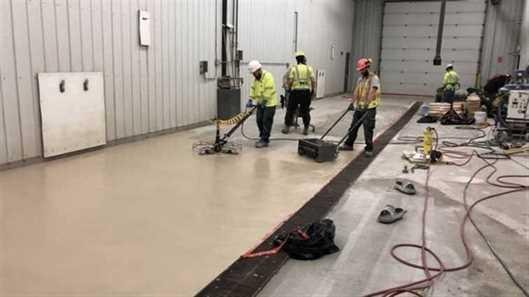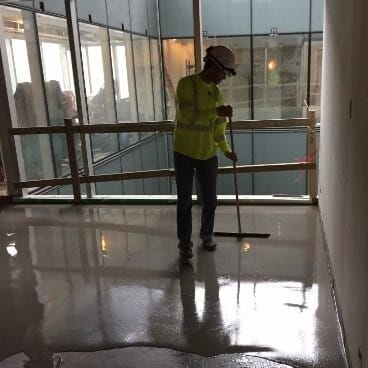 One area in which the health and safety rating of a business may fall is the quality of the atmosphere your job is in, from the air that you take into the foundation your business stands on. If the job requires team members to stand for most of the time, the floor has to be safe, without any floor hazards which might lead to injury to visitors or employees. Those hazards might range from uneven surfaces, cracks, or additional defects which might cause trips. Replacing damaged floors may decrease that risk. There are many resins that are joint free which produce a safe working atmosphere and a smooth surface. In addition to being even, the kind of flooring selected may have additional advantages to working atmospheres, like slip or chemical resistance; perfect for workspaces which encounter potentially corrosive or wet products. Slipping risk is a possible hazard for several workplaces, from shopping centers to manufacturing sites. While it’s easy to believe that this might be a risk in areas which use excess water, for instance, automotive washing spaces or wet processing sites, it’s just as huge a risk inside retail environments in which shoppers or staff might walk in water from wet weather conditions. In all these situations, the general public or staff are at risk of severe injury from slipping. In order to overcome this, a floor material that has slip resistance may be the perfect option. One other consideration as you consider flooring in workplaces is the impact upon the goods which are produced. ESD (electro-static discharge), for instance, may cause a threat to fragile electronic equipment, as well as inside environments which deal with volatile gases, liquids, powders, or additional substances. It even can be a possibly harmful ignition source. As subject to consistent traffic from wheeled equipment and people, these types of charges quickly can build up inside a floor. In order to securely dissipate electrostatic charge so you can ground it quicker than it accumulates, it’s possible to develop an electrostatic protected, controlled space through the use of a special epoxy coating. Prevention of Hazards From the chosen material to the chosen color, all these may assist in reducing workplace health and safety issues. Picking a floor of one vibrant color may make dropped objects more visible, decreasing the risk of one stumbling. Different colored floors may be utilized to identify separate site zones. It’ll work particularly well within manufacturing plants, in which one shade is utilized for the handling of a single product, and a different shade of floor is utilized for the handling of a different product. Differentiating the zones by color helps to decrease contamination, or visually display a hazardous zone which ought to be avoided by employees. Lastly, all workplaces ought to feature safety signage that warns the ones present of all possible dangers. Training sessions that are on the meaning of all signage are critical, and all rules concerning the signage must be adhered to. For more information on flooring, safety features contact the appropriate concrete finishes services of TC Floors today!
One area in which the health and safety rating of a business may fall is the quality of the atmosphere your job is in, from the air that you take into the foundation your business stands on. If the job requires team members to stand for most of the time, the floor has to be safe, without any floor hazards which might lead to injury to visitors or employees. Those hazards might range from uneven surfaces, cracks, or additional defects which might cause trips. Replacing damaged floors may decrease that risk. There are many resins that are joint free which produce a safe working atmosphere and a smooth surface. In addition to being even, the kind of flooring selected may have additional advantages to working atmospheres, like slip or chemical resistance; perfect for workspaces which encounter potentially corrosive or wet products. Slipping risk is a possible hazard for several workplaces, from shopping centers to manufacturing sites. While it’s easy to believe that this might be a risk in areas which use excess water, for instance, automotive washing spaces or wet processing sites, it’s just as huge a risk inside retail environments in which shoppers or staff might walk in water from wet weather conditions. In all these situations, the general public or staff are at risk of severe injury from slipping. In order to overcome this, a floor material that has slip resistance may be the perfect option. One other consideration as you consider flooring in workplaces is the impact upon the goods which are produced. ESD (electro-static discharge), for instance, may cause a threat to fragile electronic equipment, as well as inside environments which deal with volatile gases, liquids, powders, or additional substances. It even can be a possibly harmful ignition source. As subject to consistent traffic from wheeled equipment and people, these types of charges quickly can build up inside a floor. In order to securely dissipate electrostatic charge so you can ground it quicker than it accumulates, it’s possible to develop an electrostatic protected, controlled space through the use of a special epoxy coating. Prevention of Hazards From the chosen material to the chosen color, all these may assist in reducing workplace health and safety issues. Picking a floor of one vibrant color may make dropped objects more visible, decreasing the risk of one stumbling. Different colored floors may be utilized to identify separate site zones. It’ll work particularly well within manufacturing plants, in which one shade is utilized for the handling of a single product, and a different shade of floor is utilized for the handling of a different product. Differentiating the zones by color helps to decrease contamination, or visually display a hazardous zone which ought to be avoided by employees. Lastly, all workplaces ought to feature safety signage that warns the ones present of all possible dangers. Training sessions that are on the meaning of all signage are critical, and all rules concerning the signage must be adhered to. For more information on flooring, safety features contact the appropriate concrete finishes services of TC Floors today!
5 Flooring Safety Features
CEOMichael Rosenblat
With over 20 years in the field of technical concrete finishes, I offer a deep experience and precision in design and application of concrete floors. As founder of TCF West, I lead my team in crafting durable, aesthetically striking industrial floors. In this blog, I share industry insights to help elevate your space through quality flooring. Let’s connect to transform your environment with custom floors that meet your needs.

